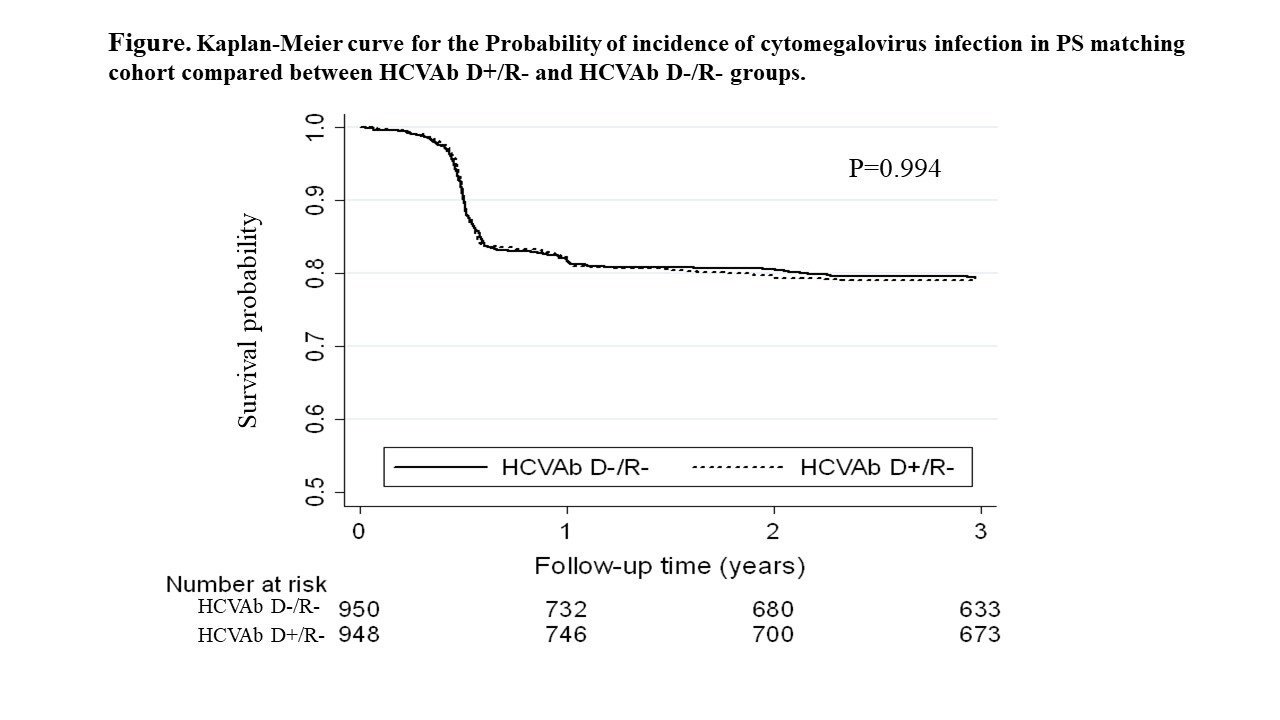Incidence of Cytomegalovirus Infection in Deceased Donor Kidney Transplantation from Hepatitis-C Antibody Positive Donors to Hepatitis-C Antibody Negative Recipients: A National Registry Analysis
M. Yazawa1, T. Fülöp2, O. Cseprekal3, M. Talwar1, V. Balaraman1, A. Bhalla1, A. Azhar1, C. P. Kovesdy4, J. D. Eason1, M. Z. Molnar1
1James D. Eason Transplant Institute, Methodist University Hospital, Memphis, TN, 2Division of Nephrology, Department of Medicine, Medical University of South Carolina, South Carolina, SC, 3Department of Transplantation and Surgery, Semmelweis University, Budapest, Hungary, 4Division of Nephrology, Department of Medicine, University of Tennessee Health Science Center, Memphis, TN
Meeting: 2020 American Transplant Congress
Abstract number: B-196
Keywords: Cytomeglovirus, Hepatitis C, Kidney transplantation
Session Information
Session Name: Poster Session B: Non-Organ Specific: Viral Hepatitis
Session Type: Poster Session
Date: Saturday, May 30, 2020
Session Time: 3:15pm-4:00pm
 Presentation Time: 3:30pm-4:00pm
Presentation Time: 3:30pm-4:00pm
Location: Virtual
*Purpose: Deceased donor kidney transplantation (KT) from hepatitis C (HCV) infected donors into HCV uninfected recipients (HCV D+/R-) will be the standard of care in the near future. HCV viral transmission and replication in HCV D+/R- might increase the risk of cytomegalovirus (CMV) reactivation/infection in these recipients.
*Methods: A National registry based retrospective cohort study was conducted using Scientific Registry of Transplant Recipients (SRTR) data set (October 1st, 1987 to March 31st, 2015). We assessed the incidence of CMV infection between HCV antibody (Ab) positive (HCVAb D+/R-) group and HCV antibody negative donor and recipient (HCVAb D-/R-) group. The risk of CMV infection was analyzed by Cox regression analysis in a propensity score (PS) matched cohort (N=1,900) of HCVAb D+/R- (n=950) versus HCVAb D-/R- (n=950) recipients. Furthermore, sensitivity analysis was also done on the entire cohort (N=181,082) using unadjusted and adjusted Cox regression analysis.
*Results: The mean±SD age of the PS matched cohort at baseline was 54±12 years, 75% were male, 41% and 55% of patients were white and African-American, respectively. The baseline characteristics of the recipients were well balanced in the PS matched cohort. Compared to HCVAb D-/R- patients, recipients with HCVAb D+/R- had similar risk for the incidence of CMV infection (Hazard Ratio (HR)=1.00, 95% Confidence Interval (CI):0.82-1.22).
In the sensitivity analysis, compared to HCVAb D-/R- patients, the HCVAb D+/R- group had a significantly lower risk of CMV infection in the unadjusted analysis (HR=0.75, 95% CI: 0.65-0.85), while this risk difference disappeared after adjustment for several potential confounders (HR=0.99, 95% CI: 0.87- 1.14).
*Conclusions: The incidence of CMV infection was similar in recipients who received HCVAb D+ and HCVAb D- kidney transplants. Further studies are needed to assess this association in recipients who received transplant from HCV infected donor (based on a positive nucleic acid test) versus uninfected donors.
To cite this abstract in AMA style:
Yazawa M, Fülöp T, Cseprekal O, Talwar M, Balaraman V, Bhalla A, Azhar A, Kovesdy CP, Eason JD, Molnar MZ. Incidence of Cytomegalovirus Infection in Deceased Donor Kidney Transplantation from Hepatitis-C Antibody Positive Donors to Hepatitis-C Antibody Negative Recipients: A National Registry Analysis [abstract]. Am J Transplant. 2020; 20 (suppl 3). https://atcmeetingabstracts.com/abstract/incidence-of-cytomegalovirus-infection-in-deceased-donor-kidney-transplantation-from-hepatitis-c-antibody-positive-donors-to-hepatitis-c-antibody-negative-recipients-a-national-registry-analysis/. Accessed December 19, 2025.« Back to 2020 American Transplant Congress

